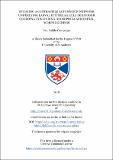Studying a contractile actomyosin network underlying larval epithelial cell behaviour coordination during Drosophila abdominal morphogenesis
Abstract
During animal development, cells undergo various behaviours, such as migration and
shape change, which need to be coordinated. How this coordination is achieved is still
elusive. During morphogenesis of the adult abdominal epidermis of Drosophila, the
larval epithelial cells (LECs) are replaced by the adult histoblasts. The LECs migrate
directedly and, subsequently, cease migration, constrict apically and die. Here, I use in
vivo 4D microscopy to study the spatial and temporal organisation of the actomyosin
cytoskeleton of LECs as a potential mechanism to coordinate migration and apical
constriction. The analysis of LECs apical actomyosin network shows that are planar
polarized during migration, undergoing pulsed contractions in the back of the cell,
while protruding at the front. During constriction, the cytoskeleton of LECs displays
radial polarity with contractions localising in the centre of the cell. Behavioural change,
thus, involves a change in the polarity of the contractile network. The properties of the
contractile network are further studied manipulating actomyosin contractility by
interfering with Rho kinase and Myosin phosphatase. The results show that the
regulation of Myosin activation not only impacts on the contractility of the network
but also on the network’s dynamics and the cell’s behaviour. A loss-of-function analysis
of several Rho-GEFs, the activators of the Rho GTPases, is performed to study the
molecular mechanisms that underlie the behavioural change. The depletion of
individual RhoGEFs identifies 5 genes involved in the regulation of specific aspects of
cell migration and the apical constriction of LECs. Altogether, the results suggest that
cytoskeletal architecture and autonomous network dynamics underlie the behaviour
of the contractile network. The results furthermore suggest that pulsed contractions,
along with the cortical actomyosin network, underlie behavioural change, being one of
the force generation mechanisms that orchestrate abdominal morphogenesis.
Type
Thesis, PhD Doctor of Philosophy
Rights
Attribution-NonCommercial-ShareAlike 4.0 International
http://creativecommons.org/licenses/by-nc-sa/4.0/
Collections
Except where otherwise noted within the work, this item's licence for re-use is described as Attribution-NonCommercial-ShareAlike 4.0 International
Items in the St Andrews Research Repository are protected by copyright, with all rights reserved, unless otherwise indicated.


